10,346 people reached on Lassi with Lavina FB page – 890 post clicks – 217 Likes
Rahul Hira, Suraj and 134 others like it on Lassi with Lavina FB page
Vanita SN, Amrita Nathani Pillai and 31 others like it on I ♥ Sindhi Food
217 views on LinkedIn – 7 Likes

Chef Roshni Gurnani at The James Beard House
Putting Sindhi Food On the Map
[dropcap]A[/dropcap] vegetarian Sindhi meal at The James Beard House! The sentence itself sounds surreal. The James Beard House, built in 1844, is of course the epitome of gastronomy, a space dedicated to the iconic chef James Beard who lived there from 1973 to 1985. It is the space where connoisseurs gather to taste the cuisine of the world’s best chefs.
Vegetarian Sindhi cuisine is a well-kept secret – one rarely tasted by the gourmands of the world. It is the food of the scattered, nomadic Hindu Sindhis who lost their beloved homeland of Sindh during the seismic, bloody Partition of 1947 in which undivided India was sliced up into two new nations by the British. Hundreds of thousands of Hindu Sindhis fled their homeland of Sindh while Muslims made the reverse journey to Pakistan.
The Hindu refugees fled Sindh without many material belongings and had to start over again. Many became instantly penniless but carried their memories, their sweet language, their music and their very special recipes with them. They became the world’s wanderers, struggling and succeeding in many parts of the world while holding on to their language, culture – and delicious food.
All Photographs courtesy The James Beard Foundation
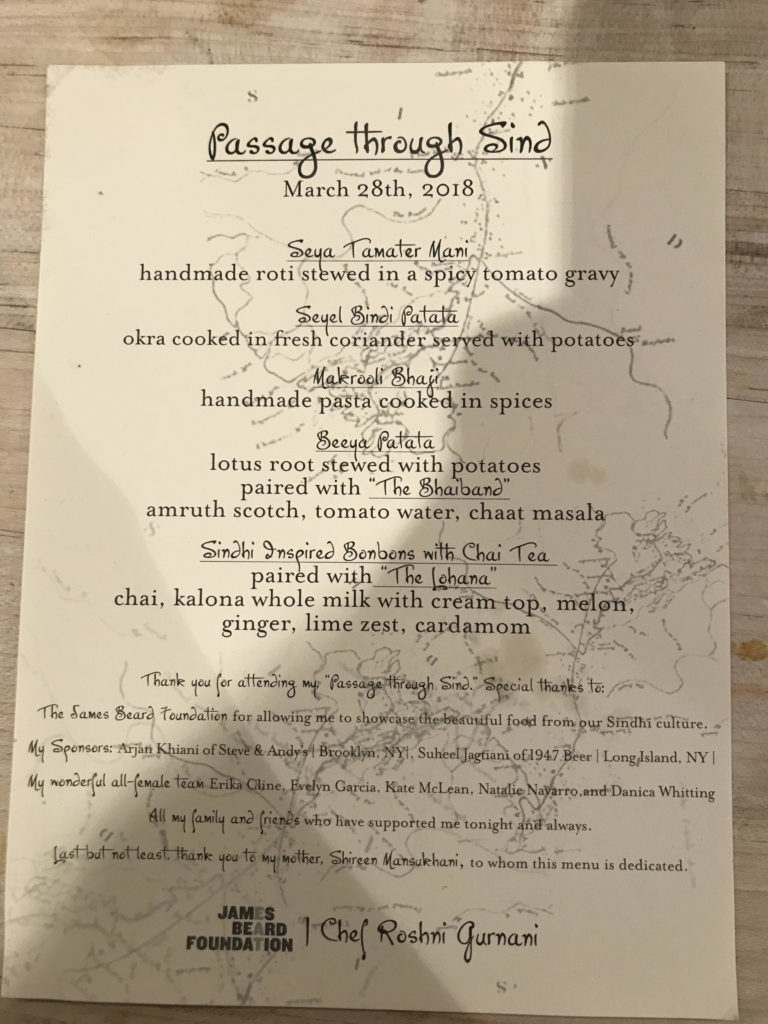

[dropcap]S[/dropcap]o a vegetarian Sindhi meal at the James Beard House is indeed a unique event, and the one selected to introduce it to the larger world is Chef Roshni Gurnani who is the chef at Hotel Derek in Houston, Texas. She offered a really old world treat for gourmets but as interpreted by a modern day Sindhi chef. She herself is a second -generation Indian American and came to Sindhi food by osmosis, having been fed this real soul food by her mother and her grandmothers from childhood.
Gurnani’s grandparents were among the Hindus who had to flee their home to make a new life in the new independent India, carrying their Gods and their few possessions with them.
[dropcap]F[/dropcap]or most Hindu Sindhis, vegetarian food is important, especially on religious days and an entire repertoire has been built around that. Gurnani chose to showcase the traditional dishes which could be reproduced well on a global gourmet table.
I myself being Sindhi shared tables with other New York foodies at this dinner, and randomly happened to be an a table with two second-generation Sindhis, a Cuban and his Jewish American wife, and a Puerto Rican from Philadelphia The meals had been successfully translated for a multi-culti table with the original flavors intact but the spices toned down. For the Sindhis amongst us, it was about remembered childhood, when these were the meals we all ate every day. Now many of us eat diverse meals in different parts of the world with little access to the beloved home cooks of our youth!
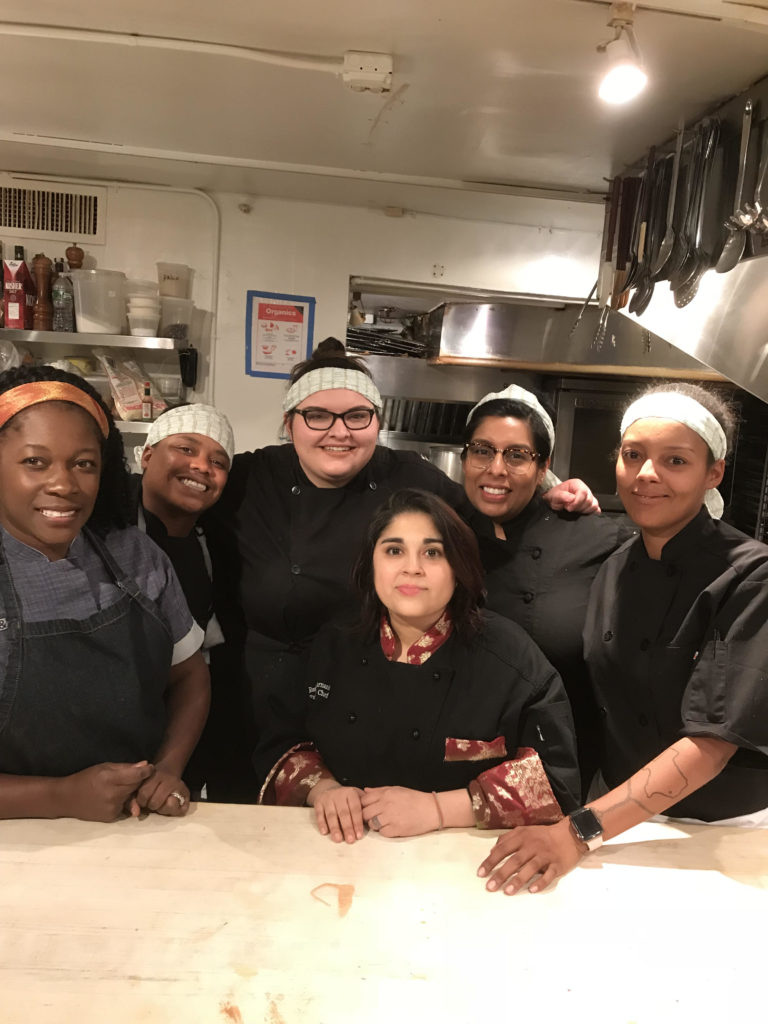
[dropcap]“F[/dropcap]or the past three years of my career I have worked and continue to work toward putting Sindhi food on the map,” says Chef Roshni Gurnani who had brought in an-all women team. “When I was invited to JBH I knew right away that I wanted to do Sindhi food and showcase each element of it. Sindhi cuisine is very special with a flavor all its own yet it is not well-known. Sindhi cuisine started off in Persia with the Mugals and slowly moved toward Pakistan and now modern day India.. As the flavors are slightly different with each region, it shares the techniques and practices that are very similar. It is simple yet rich at the same time and showcases the specific ingredient of the dish respectfully.”
After the partition of India, Hindu Sindhis had to leave their homeland of Sindh as refugees. Had their cuisine has undergone changes as they’ve traveled to various parts of the world to search for work and a new home? Says Gurnani, “I think that the Sindhi Hindus have a lot more vegetarian dishes then Sindhis in Pakistan. I think some dishes may have a little bit of difference to them but the techniques and flavors are similar.”
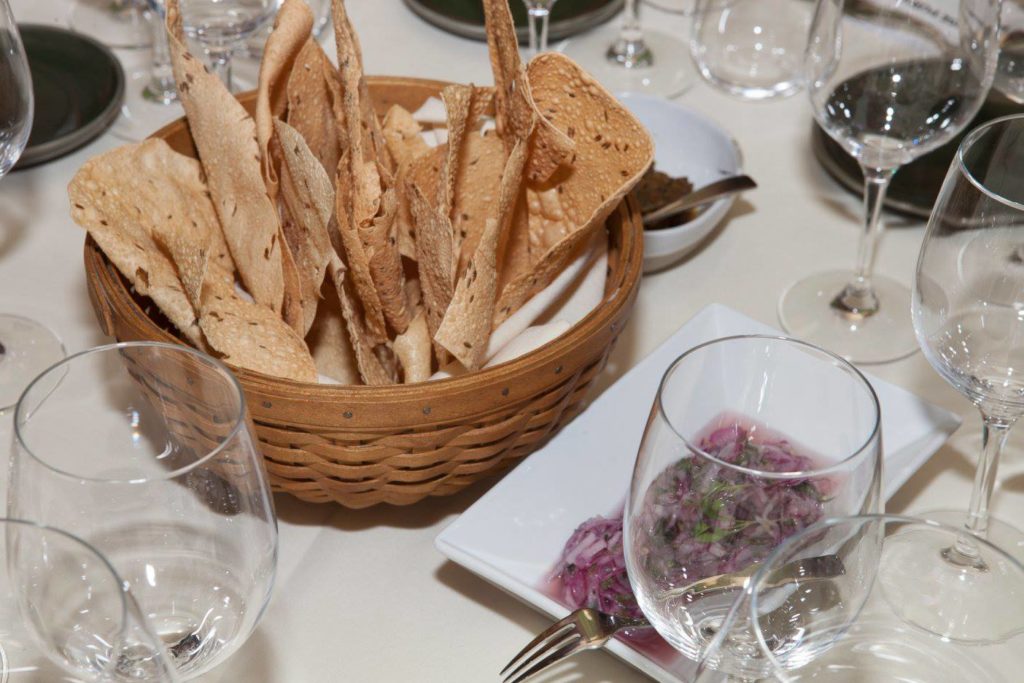
[dropcap]A[/dropcap]sked for her memories of growing up with Sindhi food, she said: “Growing up we ate Sindhi food daily. It was just food for us and we never considered it or thought there was a difference in Sindhi food and other foods. For us it was the only food we knew. Some favorites were “loli (flatbreads), patata ji mani (flatbreads with potato filling) and seyal Bindhiya (Okra simmered in onion and tomatoes) ”
The evening began with appetizers and cocktails in the veranda of JBF – a lovely atmospheric townhouse once home to the iconic James Beard himself and now the venue for these celebrity chef dinners and many cooking demonstrations. The appetizers were old favorites from a typical Sindhi table – sana pakora and daal pakvan. Sindhis have grown up on dal pakvaan as breakfast and light lunch – and this was the stylish, gourmet version – petit pakvans but retaining the crispness and the earthy flavors of the dal which was almost like a dip.
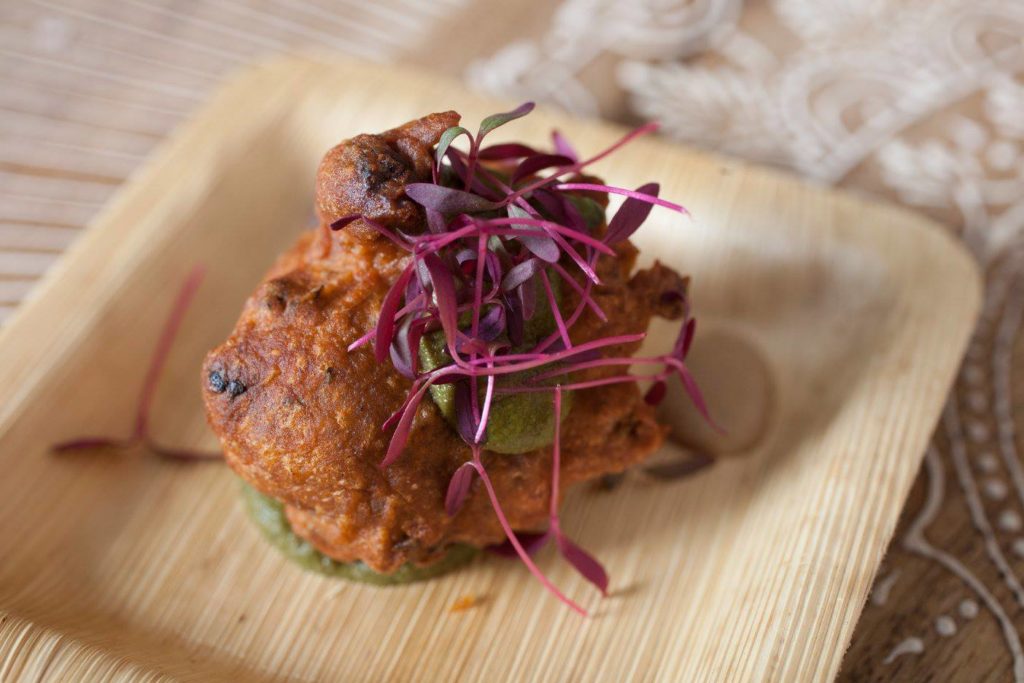
[dropcap]A[/dropcap]lthough Gurnani has traveled the world, Sindhi food is the foundation she has built on. “No matter where in the world I traveled or worked, being Sindhi and eating Sindhi food was who I am,” she says. “Introducing Sindhi flavors into my common American dishes is what I have been doing. For example doing a whole leg of goat but cooked in seyal masala. Or doing mini Pakwan with daal and creating nachos out of it.”
Asked about her menu for the James Beard dinner, Gurnani says, ” I did all my childhood favorites. I knew exactly what I wanted and wanted to do it vegetarian since I was inviting my mom who has been my inspiration and to whom I was dedicating the dinner. For passed cocktail hour, I had mini daal pakwan, Sana pakora (vegetable fritter), and king mushrooms cooked in a rich onion gravy.
[dropcap]F[/dropcap]or dinner, I started off with seyal mani, a traditional Sindhi dish made of chapati bread that is stewed in tomatoes, curry leaves and mustard seeds. I also did the famous seyal bindi, which is okra in cilantro sauce and potatoes. Beya patata was also a course. This is lotus root and potatoes. Except I topped it with lotus root chips.”
[dropcap]W[/dropcap]e then went up to the elegant JBF dining room where we sat down to a 5 course meal, each accompanied by a a different alcoholic drink. It all began with papads – lentil fritters – which was a must in any Sindhi household – here it was served as a starter with pickle and onion kachumbar. Why does every Sindhi meal begin with papad? Asked this question, Gurnani laughed, “Apart from the fact that every Sindhi person loves papad!” There was however, a deeper reason for the popularity of papads – During the partition Sindhi women hand made papads at refugee camps and sold them to bring in an income. It was often a way of survival for some families.
The takeaway from the diners of varied nationalities at my table was that you never felt it was restaurant food – heavy and creamy – but light home food served in a plated, modern way. The spices and heat were in low volume for a global audience, but could be turned up with added heat. It certainly was there to whet everyone’s appetite for a full-fledged Sindhi meal.
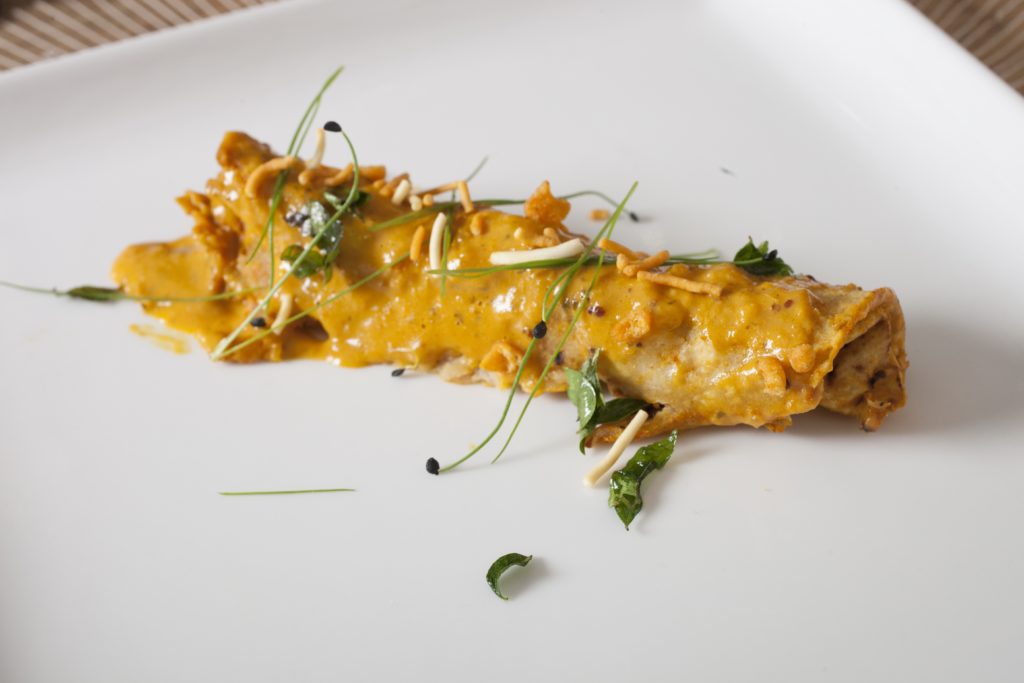
[dropcap]S[/dropcap]ome recipes were like half-remembered dreams which disappear on waking. The macaroni of childhood was very different from this pasta shell interpretation. I realized these dishes were bound to taste different, each being from a different family root or akai – passed down orally and in the Sindhi language, long before the internet. Family recipes were bound to be different in their spicing, in their heat, in their method. It was like eating in your neighbor’s house, remembered tastes but with different spicing.
I asked Gurnani whether she would you call these authentic dishes or her own interpretation of a very old cuisine? “The dishes I presented were authentic in flavor and cooking techniques but with my my own modern interpretation of plating,” she said. “The hardest part of the menu was practicing how I will plate the food. I wanted each dish to be a plated course and make it look elegant. So this for me was something that took about a month of playing around with.”
I asked her to tell me about the various alcohol beverages she served, especially the Sindh-inspired ones. She said she had named each of the cocktails after a different community of Sindhis which include the Lohana, the Saiti, the Amil and the Bhaiband. Each of these sub-communities had a different profession in the old days.
“My mixologist who flew in from Houston and I worked for a few months coming up with different flavors to complement the food.,” says Gurnani. “We used Bombay Sapphire Gin, Sufi Wines and Amrut’s Whiskey to keep it as Indian as possible and mixed the different cocktails with Indian juices such as mango, guava, lychee and used Limca soda also. We used a lot of fresh coconut water, amchur powder and chaat masalas for the various drinks, and also used a local Sindhi beer called 1947 for cocktail hour.”
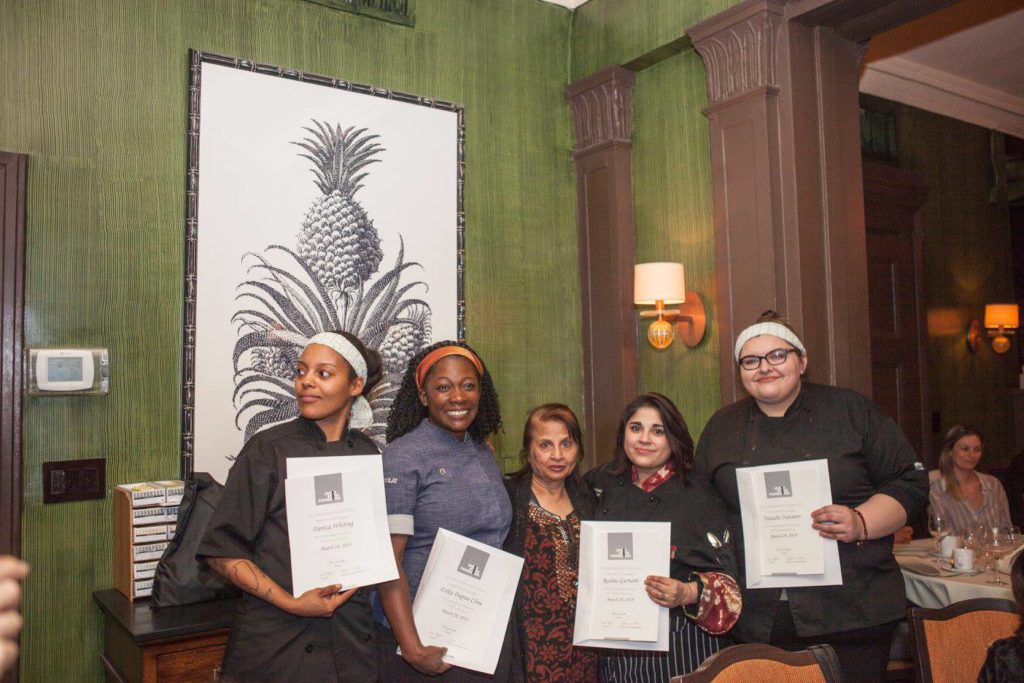
[dropcap]C[/dropcap]hef Rosh and her team presented dish after dish as a work of art and at the grand finale brought in the fantastic desserts and ginger-infused chai. The desserts were made by Gurnani’s personal friend who is a noted chocolatier out of Florida. She did Sindhi inspired chocolates flavored with cardamom and saffron. Gurnani also gave each guest a box of cookies to take with them from Steve and Andy’s, a local NYC cookie company owned by Arjan Khiani, a local Sindhi baker.
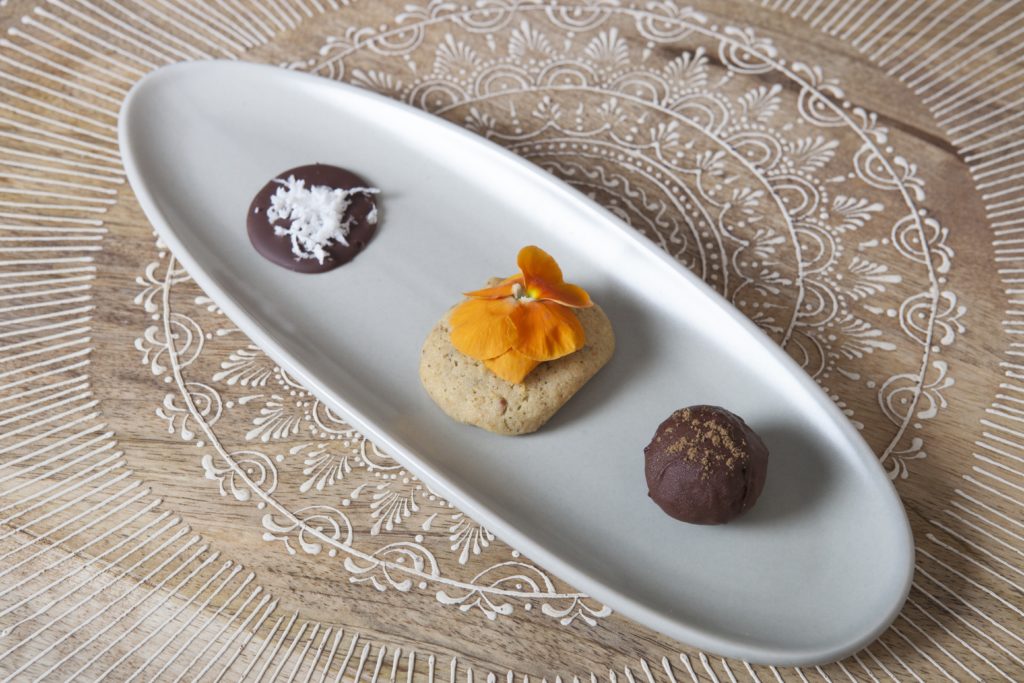
[dropcap]I[/dropcap]n the packed room, Gurnani dedicated the meal to Shireen Mansukhani, her mother who was the source of inspiration for the meal. Sadly, a few days later she passed away but was there at this grand moment to see her daughter share the joy and deliciousness of Sindhi family cooking with the larger world.
Indeed food is all about memory and remembrance, of how what you cook can connect you to your loved ones and your family traditions.
“I was so happy for her to be there and to be able to serve the food she cooked for us as children,” recalled Gurnani. “At the end of the night she said she was very proud of me and was excited to see where else Sindhi food can take me.”
Incidentally Sindhi cuisine is more than vegetarian food – it has a very strong non-vegetarian component with rare dishes which are not found in any other food culture – seyal theevan, methi thoom macchi and pavas (sheep trotters) to name a few. We hope JBF will invite Chef Gurnani to give us a taste of the other part of Sindhi cuisine!
What are your thoughts and memories of Sindhi food? Do share with readers in the comments!
Related Articles:
Chef Roshni – Indian Food Evangelist
Indian Cuisine – Home Food at Sindhi Rasoi

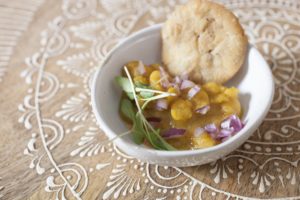
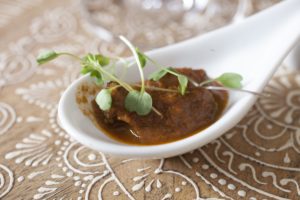

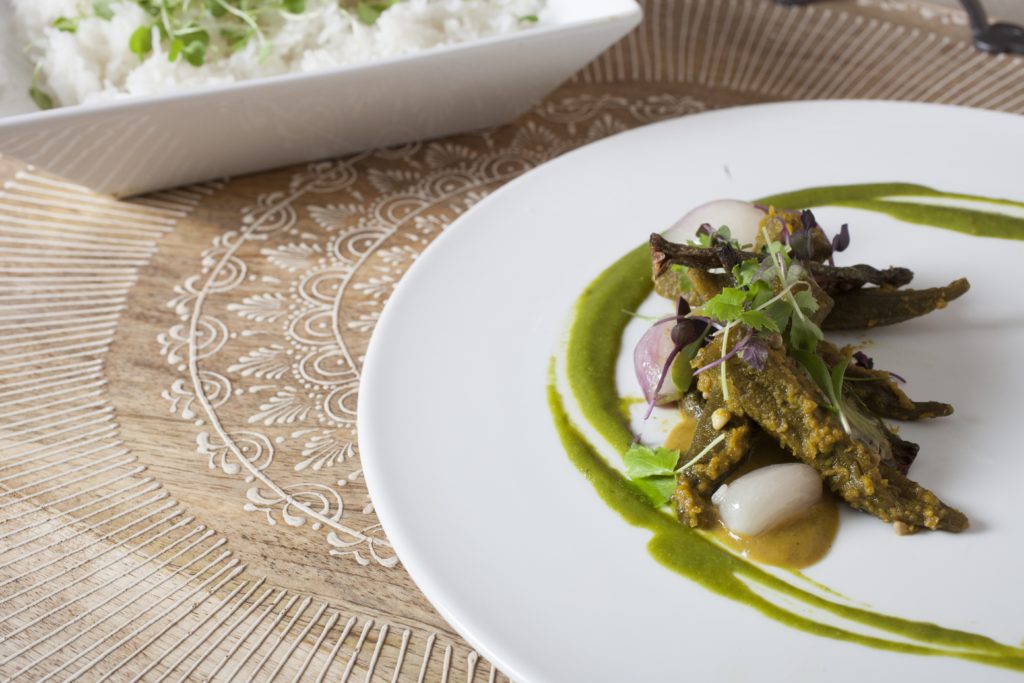
3 Comments
Maya Shahani via Facebook
Good going – keep it up
I agree!
Dottie Sheth via Facebook
That’s such an honor!